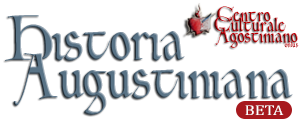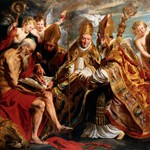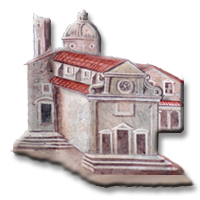The Four Doctors (from the Latin for teacher) are to be identified by their attributes: Saint Jerome with the lion (and cardinal's hat), Saint Augustine with the flaming heart, Saint Gregory with the dove, and Saint Ambrose with the beehive (expressing the sweetness of his discourse, pace Rooses, loc. cit.).
From the Middle Ages these Saints when grouped together were known as the Four Doctors of the Church, see The Oxford Dictionary of the Christian Church ed. F.L. Cross and E.A. Livingstone, 2nd ed., revised, Oxford, 1974, p. 414, under Doctors of the Church; Rooses for the present composition with some justification, see the Enciclopedia Cattolica, Rome, IV, 1950, under Dottori della Chiesa, adopted the title The Four Latin Fathers of the Church, which has been that subsequently used (apart from by Tudor-Hart). As the appellation Doctor was used in Antwerp in Jordaens's time in reference to this picture, it is re-adopted here. The writings on the Faith by these Saints respectively from the left a Cardinal, Bishop, Pope and Bishop, and all of the early Church, were subsequently acknowledged by papal decree as those which had special authority.
The composition was known to Smith and Rooses as Rubens's work by virtue of Galle's print. Tudor-Hart's publication of the present lot as the work of Jordaens in the Stonyhurst Magazine, probably failed to come to the attention of art historians, so van Puyvelde published a later version (now considered to have been executed with the help of the studio) as the original (see L. van Puyvelde, Die vier Kirchenlehrer von Jordaens, Pantheon, XVIII, 1936, pp. 360-362, and L. van Puyvelde, Jordaens, Paris and Brussels, 1953, pp. 123-124 and fig. 82). This was offered by the Chrysler Museum, Norfolk, Virginia, at Sotheby's, New York, 2 June 1989, lot 8.
After the present lot's exhibition in Manchester in 1960, it has been generally accepted as the prototype of Galle's engraving and thought to have been executed by Jordaens after a modello by Rubens, by virtue both of the inscription on Galle's print, which credited Rubens with the design but not the execution of the prototype, and of the description of it in the de Neyt inventory of 1642 as the work of Rubens and Jordaens: 'Een groot stuck op doek in lyste, inhoudende de vier Doctoren vande Heylige Kercke, gemaect door Rubens ende Jordaens'. Vlieghe included the present work as no. 60 in his Corpus volume ofSaints, I, in 1973; he suggested (his no. 60a, following Burchard) that Rubens's modello, on which Jordaens relied when executing the picture, may have been that recorded in the inventory of the collection in Antwerp of the landscape painter Jeremias Wildens of 1653. His was a huge collection; in it was listed a 'De Vier Doctoren, geschift, (sic = geschist = sketch) van Rubbens', see Denucé, op. cit., p. 144 and p. 166. This possible identification is passed over by d'Hulst in Devisscher and de Poorter, loc. cit., and by Balis, loc. cit.
The execution of the present lot was last dated by d'Hulst to c. 1630; Balis has dated it to '[Jordaens's] typical rough style of the early 1620s', which is preferable to Vlieghe's dating to 'the late thirties or even about 1640'.
Balis excluded the possibility that the present lot was executed by Jordaens in Rubens's studio; he stated that 'only technical analysis could establish whether Jordaens here remodeled a painting begun by Rubens ... or whether (less probable) he executed the entire painting himself, starting from an oil sketch which Rubens may have provided'. Balis's concern here is presumably the angels, whose execution is not as 'rough' as those of the main figures. However, it would have been quite inappropriate for the angels to have been executed with the same powerful exhuberance that characterizes the depiction of the four Doctors. Indeed for those on the left, similarities can be found in Jordaens's Study of a small Child at Gdansk and Study of a Child's Head in a private collection (see Devisscher and de Poorter eds., nos. A17 and A36, where dated c. 1620 and 1626 respectively). The angel on the right is more Rubensian, an observation which further justifies the thesis that Jordaens was relying on a modello by Rubens; this angel holding the beehive is acceptable too as the work of Jordaens. The pentimento in the head of Saint Jerome and the manner of execution display Jordaens's independent approach, however much he may have relied on a design by Rubens.
Rubens had depicted Saint Gregory in the altarpiece for the Chiesa Nuova, and with Saints Augustine, Ambrose and Jerome in the Real Presence of the Holy Sacrament in St. Paul's, Antwerp (see Vlieghe, op. cit., II, no. 109, and I, no. 56). The face of Saint Gregory in the present lot connects with that of the Saint Gregory, as identified by Vlieghe, in the St. Paul altarpiece; the Saint Jerome derives from the (unidentified by Vlieghe) Saint in the centre of the same altarpiece, which was later to be converted into a Saint Jerome (in reverse) by Rubens in the picture at Dresden (see Vlieghe, Saints, II, no. 121). Saint Ambrose can be seen as a development of the pose and facial type designed for the saint by Rubens in the Vienna Emperor Theodosius forbidden to enter Milan Catheral (see R. Oldenbourg, Rubens, Klassiker der Kunst, [1921], p. 191).
Balis considers the present lot as an example of a 'closer association between Jordaens and Rubens' than in the second half of the second decade of the century. However the circumstances in which the present lot was executed by Jordaens probably after a modello by Rubens remains unknown. That Herman de Neyt owned the picture in 1642 is of little help in elucidating the question: perhaps all that can be inferred is that the person or institution for whom the picture may have been executed had subsequently sold it to de Neyt, or that he had acquired it from Jordaens. De Neyt's collection (and/or stock) has been described as one of the most important in 17th Century Antwerp (see under lot 42). His selection of the present picture as one that should be engraved and decision that the print be dedicated to a notable art lover, is indicative of de Neyt's high regard for it.
As d'Hulst in 1982 pointed out, the popularity of the design is shown by the existence of two later versions executed with the help of the studio: that in the Chrysler Collection offered at Sotheby's, New York, see above, on canvas 182 x 242.5cm., and that in the Nationalmuseum, Stockholm, on canvas 219 x 252cm., (see Rooses, loc. cit. and d'Hulst, in Devisscher and de Poorter eds., loc. cit. and note 6). Van Puyvelde in 1953 recorded a copy in a private collection, Brussels (earlier in the Maria Dornholm collection, Vienna, and ex-C. Barbier sale, Fiévez, Brussels, 12-13 June 1912, lot 107, on canvas, 165 x 225cm.).
The status of the smaller pictures relating to Galle's print, recorded by Smith as in the François Tronchin des Delices sale, Paris, 23-24 March 1801, and by Rooses in the J.B. Horion sale, Brussels, 1 September 1788, remains a matter of hypothesis only since their present whereabouts are unknown.
Fonte: www.christies.com



